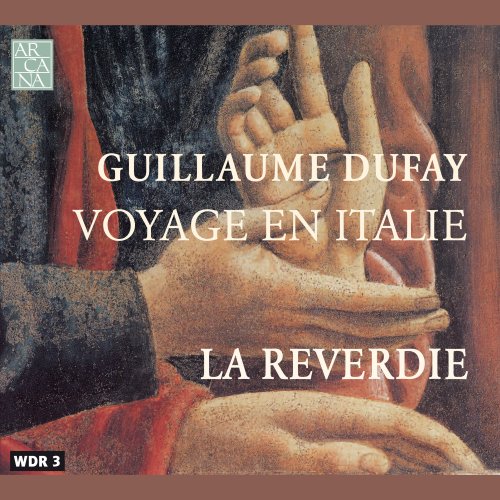
La Reverdie - Dufay: Voyage en Italie (2009)
BAND/ARTIST: La Reverdie
- Title: Dufay: Voyage en Italie
- Year Of Release: 2009
- Label: Arcana
- Genre: Classical
- Quality: flac lossless (tracks)
- Total Time: 01:03:40
- Total Size: 322 mb
- WebSite: Album Preview
Tracklist
01. Supremum est mortalibus bonum (Motet isorythmique)
02. O spirito gentil (Ballata)
03. Morir desio (Ballata)
04. Excelsa civitas Vincencia (Motet)
05. Quel fronte signorille in paradiso (Canzone)
06. C’est bien raison de devoir essaucier (Ballata)
07. Belfiore (Danse)
08. O felix flos Florencia-Gaude felix Dominice (Motet)
09. Vasilissa ergo gaude-Concupivit rex (Motet isorythmique)
10. O sancte Sebastiane-O martyr Sebastiane-O quam mira refulsit gratia-Gloria et honore (Motet isorythmique)
11. Exultet celum laudibus (Hymne)
12. Mirandas parit hec urbs (Motet)
13. O proles Hispanie-O sidus Hispanie (Motet)
This release paints a musical portrait of the young Guillaume Dufay and of the musical world he encountered when he traveled to Italy as a young man. Accordingly, it avoids the famous Dufay pieces such as the Missa Se la face ay pale, the Missa L'homme armé, or the motet Nuper rosarum flores; what you hear here is Dufay's style, which in many respects became the international style for much of the Renaissance era, coming together. The multinational group La Reverdie suggests that one aspect of this style, a freely melodic counterpoint, came from Italian sources, and crucially from the rise of Italian humanism, rather than from the Flemish and British styles usually emphasized in connection with Dufay. The album introduces several composers almost unknown to general listeners: Prepositus Brixiensis, Bartholomeus de Bononia, Bertrandus Ferraguti, and Antonius da Civitate. These composers are from an almost unknown generation following that of the first Flemish-Italian transplant, Johannes Ciconia. The disc is perhaps aimed at specialists, with the notes referring to white and black mensural notation and containing such sentences as this: "The syllable FA is interpreted as a sign of solmisation in soft hexachordum, which signifies B flat in modern terms." (The "soft hexachord" in medieval singing corresponded to the notes F-G-A-B flat-C-D.) But even for general listeners this disc marks a step forward in performing Dufay, who is difficult to put across to modern audiences. What did the dizzying complexity of the isorhythmic motet sound like to the popes who paid big money to bring Dufay across the Alps? What did the simpler music of Italy, beginning to enter into a new and radically organic connection to the text, sound like to Dufay? The spare (the music is accompanied by a small string group), rather ecstatic performances of this young ensemble help the listener to begin grappling with these questions. Notes are in French, Italian, German, and English; so are all work texts, although they are not given in parallel.
01. Supremum est mortalibus bonum (Motet isorythmique)
02. O spirito gentil (Ballata)
03. Morir desio (Ballata)
04. Excelsa civitas Vincencia (Motet)
05. Quel fronte signorille in paradiso (Canzone)
06. C’est bien raison de devoir essaucier (Ballata)
07. Belfiore (Danse)
08. O felix flos Florencia-Gaude felix Dominice (Motet)
09. Vasilissa ergo gaude-Concupivit rex (Motet isorythmique)
10. O sancte Sebastiane-O martyr Sebastiane-O quam mira refulsit gratia-Gloria et honore (Motet isorythmique)
11. Exultet celum laudibus (Hymne)
12. Mirandas parit hec urbs (Motet)
13. O proles Hispanie-O sidus Hispanie (Motet)
This release paints a musical portrait of the young Guillaume Dufay and of the musical world he encountered when he traveled to Italy as a young man. Accordingly, it avoids the famous Dufay pieces such as the Missa Se la face ay pale, the Missa L'homme armé, or the motet Nuper rosarum flores; what you hear here is Dufay's style, which in many respects became the international style for much of the Renaissance era, coming together. The multinational group La Reverdie suggests that one aspect of this style, a freely melodic counterpoint, came from Italian sources, and crucially from the rise of Italian humanism, rather than from the Flemish and British styles usually emphasized in connection with Dufay. The album introduces several composers almost unknown to general listeners: Prepositus Brixiensis, Bartholomeus de Bononia, Bertrandus Ferraguti, and Antonius da Civitate. These composers are from an almost unknown generation following that of the first Flemish-Italian transplant, Johannes Ciconia. The disc is perhaps aimed at specialists, with the notes referring to white and black mensural notation and containing such sentences as this: "The syllable FA is interpreted as a sign of solmisation in soft hexachordum, which signifies B flat in modern terms." (The "soft hexachord" in medieval singing corresponded to the notes F-G-A-B flat-C-D.) But even for general listeners this disc marks a step forward in performing Dufay, who is difficult to put across to modern audiences. What did the dizzying complexity of the isorhythmic motet sound like to the popes who paid big money to bring Dufay across the Alps? What did the simpler music of Italy, beginning to enter into a new and radically organic connection to the text, sound like to Dufay? The spare (the music is accompanied by a small string group), rather ecstatic performances of this young ensemble help the listener to begin grappling with these questions. Notes are in French, Italian, German, and English; so are all work texts, although they are not given in parallel.
As a ISRA.CLOUD's PREMIUM member you will have the following benefits:
- Unlimited high speed downloads
- Download directly without waiting time
- Unlimited parallel downloads
- Support for download accelerators
- No advertising
- Resume broken downloads


